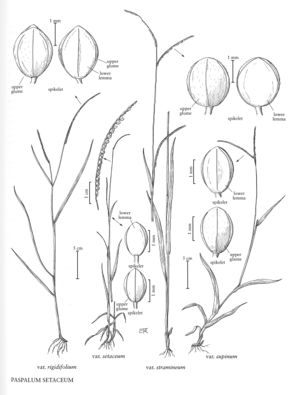Difference between revisions of "Paspalum setaceum var. supinum"
FNA>Volume Importer |
FNA>Volume Importer |
||
| Line 7: | Line 7: | ||
|synonyms={{Treatment/ID/Synonym | |synonyms={{Treatment/ID/Synonym | ||
|name=Paspalum supinum | |name=Paspalum supinum | ||
| − | |authority= | + | |authority= |
| + | |rank=species | ||
}} | }} | ||
|hierarchy=Poaceae;Poaceae subfam. Panicoideae;Poaceae tribe Paniceae;Paspalum;Paspalum setaceum;Paspalum setaceum var. supinum | |hierarchy=Poaceae;Poaceae subfam. Panicoideae;Poaceae tribe Paniceae;Paspalum;Paspalum setaceum;Paspalum setaceum var. supinum | ||
| Line 19: | Line 20: | ||
-->{{Treatment/Body | -->{{Treatment/Body | ||
| − | |discussion=<p>Paspalum setaceum var. supinum grows at the edges of forests and in disturbed areas. Within the Flora region, its range extends from Texas, Arkansas, and Louisana to South Carolina, Georgia, and Florida.</p><!-- | + | |discussion=<p><i>Paspalum setaceum </i>var.<i> supinum</i> grows at the edges of forests and in disturbed areas. Within the Flora region, its range extends from Texas, Arkansas, and Louisana to South Carolina, Georgia, and Florida.</p><!-- |
| − | --><p>Paspalum setaceum var. supinum resembles var. muhlenbergii, differing in its spreading habit and, usually, in its spikelet shape and lack of a midvein on the lower lemma.</p> | + | --><p><i>Paspalum setaceum </i>var.<i> supinum</i> resembles <i></i>var.<i> muhlenbergii</i>, differing in its spreading habit and, usually, in its spikelet shape and lack of a midvein on the lower lemma.</p> |
|tables= | |tables= | ||
|references= | |references= | ||
| Line 29: | Line 30: | ||
-->{{#Taxon: | -->{{#Taxon: | ||
name=Paspalum setaceum var. supinum | name=Paspalum setaceum var. supinum | ||
| − | |||
|authority=(Bosc ex Poir.) Trin. | |authority=(Bosc ex Poir.) Trin. | ||
|rank=variety | |rank=variety | ||
| Line 36: | Line 36: | ||
|basionyms= | |basionyms= | ||
|family=Poaceae | |family=Poaceae | ||
| − | |illustrator=Linda A. Vorobik | + | |illustrator=Linda A. Vorobik;Cindy Roché |
| + | |illustration copyright=Utah State University | ||
|reference=None | |reference=None | ||
|publication title= | |publication title= | ||
|publication year= | |publication year= | ||
|special status= | |special status= | ||
| − | |source xml=https:// | + | |source xml=https://jpend@bitbucket.org/aafc-mbb/fna-data-curation.git/src/f50eec43f223ca0e34566be0b046453a0960e173/coarse_grained_fna_xml/V25/V25_1482.xml |
|subfamily=Poaceae subfam. Panicoideae | |subfamily=Poaceae subfam. Panicoideae | ||
|tribe=Poaceae tribe Paniceae | |tribe=Poaceae tribe Paniceae | ||
Revision as of 20:34, 16 December 2019
Plants usually spreading. Leaves mostly cauline; blades to 31 cm long, 2.2-19 mm wide, lax to straight, long pubescent, hairs 1.5-4 mm, yellow-green, margins ciliate, with long stiff hairs. Panicle branches 2.2-9.9 cm; branch axes 0.6-1.5 mm wide. Spikelets 1.7-2.1 mm long, 1.2-1.6 mm wide, elliptic to obovate (rarely suborbicular), glabrous or pubescent; lower lemmas with or without an evident midvein; upper florets 1.7-2.1 mm.
Discussion
Paspalum setaceum var. supinum grows at the edges of forests and in disturbed areas. Within the Flora region, its range extends from Texas, Arkansas, and Louisana to South Carolina, Georgia, and Florida.
Paspalum setaceum var. supinum resembles var. muhlenbergii, differing in its spreading habit and, usually, in its spikelet shape and lack of a midvein on the lower lemma.
Selected References
None.
